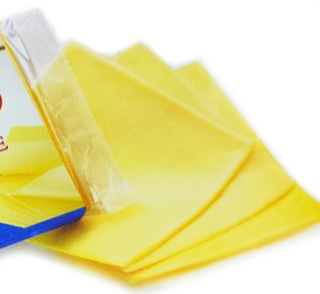American Cheese Nutrition facts
American cheese is a processed dairy item made from a blend of "optional cheeses" such as cheddar, Colby, washed curd cheese, or granular cheese, or any mixture of two or more of these.
This creamy, semi-soft, and smooth textured cheese is made from pasteurized cow's milk. It was manufactured in the United States for the first time in the early 19th century.
 |
| American process cheese slices |
USDA commodity requirements for pasteurized process American Cheese for use in domestic programs (Code of Federal Regulations) are as follows:
"Process American cheese" is made by combining more than one specified "optional cheese."
"Process American cheese food", on the other hand, is labeled so because it is made by adding traditional cheese with dairy ingredients such as cream, milk, skim milk, buttermilk, cheese whey, or albumin from cheese whey. The cheesemakers should conform to guidelines laid down in Title 21, Volume 2, Sec. 133.173 for making Pasteurized process cheese food.
The processed cheese or blended cheese shall be processed in plants, which are approved by Agriculture Marketing Service (AMS). The USDA AMS plant approval code must match the appropriate product or operation code for the commodity being offered.
When ready for grinding, the natural cheese or cheeses used to produce process cheese or blended cheese shall be properly cleaned; free from all impurities, mold, rind rot, thick dry rind, paraffin, soft spots, cheese pests, and any objectionable surface flavor or condition which may detract from the quality of the finished product.
The process cheese or blended cheese shall be pasteurized at a temperature of not less than 165° F for a period of not less than 30 seconds.
Manufacturing of processed American cheese
Pasteurized process cheese: Traditional cheese like cheddar is ground, mixed, and heated until it forms a uniform mixture with a medium-firm consistency and melts easily.
To pasteurize, the cheese mixture must be heated to a temperature of at least 150 ° F (66 ° C) for a minimum of 30 seconds. The finished product fat content must be >47%.
Pasteurized process cheese food: It is made from not less than 51% of the final weight of one or more "optional cheese ingredients" mixed with other optional dairies such as cream, milk, skim milk, cheese whey, or albumin from cheese whey and specified non-dairy ingredients such as emulsifiers. Moisture must be <44%, and fat content &g;23%.
Pasteurized process cheese spread: It is made similarly to Pasteurized process cheese food but must be spreadable at 70° F. Moisture must be between 44% and 60%, and fat content >20%.
Advantages of processed cheese
Processed cheese has an extended shelf-life.
Economically cheaper.
Its low melting point is suitable for a variety of dishes.
Emulsifiers in processed cheese prevent the separation of fats and proteins in molten cheese.
Processed cheese has an inferior taste, and a small range of flavors when compared to non-processed cheese.
It contains saturated fats, sodium, cholesterol, chemical preservatives, artificial colors/flavors, and trans-fats which are often criticized for their possible health effects.
Disadvantages of processed cheese
Health benefits of American cheese
It is a high-calorie dairy product; 3.5 oz (100 g) holds 368 calories and 30.6 g of fats. Nonetheless, it is one of the finest sources of several nutrients including vitamin D and protein.
It is a very good source of dietary calcium and phosphorous. Further, it is also fortified with vitamin D (301 IU or 50% of RDI). Consumption of American cheese in the diet helps in bone strengthening and growth, especially in children.
American cheese provides high-quality protein that is rich in all essential amino acids needed for growth and development and helps stay healthy. 3.5 oz (100 g) Brie contains 18 g or about 32% of the recommended daily intake of protein.
American cheese being a dairy product, is free of gluten. In gluten-sensitive (Celiac disease) persons, it is another important source of gluten-free food items rich in protein, minerals, and vitamins.
Besides vitamin D, it is also a very good source of fat-soluble vitamins, especially vitamin A. 3.5 Oz contains 1000 IU (33% of RDI) of vitamin A, which is an important factor for good vision and maintaining the integrity of mucosa and skin.
American cheese is a very concentrated source of minerals, especially calcium (87% of RDI), phosphorus (70% of RDI), zinc (37% of RDI), iron (6%) and magnesium (6%) per 3.5 oz (100 g).
| Principle | Nutrient Value | Percent of RDA |
|---|---|---|
| Energy | 368 Kcal | 18.4% |
| Carbohydrates | 5.27 g | 4% |
| Protein | 18 g | 32% |
| Total Fat | 30.6 g | 153% |
| Saturated fats | 18.1 g | 181% |
| Cholesterol | 98 g | 32.6% |
| Dietary Fiber | 0 g | 0% |
| Vitamins | ||
| Niacin | 0.095 mg | <% |
| Pyridoxine | 0.056 mg | 4% |
| Riboflavin | 0.247 mg | 19% |
| Thiamin | 0.015 mg | 1% |
| Vitamin-A | 1000 IU | 33.33% |
| Vitamin-C | 0 mg | 0% |
| Vitamin-D | 301 IU | 50% |
| Vitamin-E | 0.79 mg | 5% |
| Vitamin-K | 3.2 µg | 2.7% |
| Electrolytes | ||
| Sodium | 1660 mg | 110.7% |
| Potassium | 149 mg | 3% |
| Minerals | ||
| Calcium | 866 mg | 86.6% |
| Copper | 0.046 mg | 5% |
| Iron | 0.48 mg | 6% |
| Magnesium | 25.1 mg | 6.25% |
| Manganese | 0.038 mg | 1.5% |
| Phosphorus | 540 mg | 77% |
| Selenium | 20.4 mg | 1.5% |
| Zinc | 2.42 mg | 37% |
Buying guide for American cheese
Process American cheese is often sold in blocks, packed in individual slices (cheese singles), sometimes with plastic wrappers or wax paper separating them.
When buying, check for a reliable source and read the labels to make sure that the product is well within its expiration date.
Also, check for appearance, smell, and flavor. Avoid strong flavor (ammonia), sour milk, and unclean odors. Look for the trimmings if they are clean and free of mold, soft spots, etc.
Storing
Like much other fresh cheese, American processed cheese also spoils quickly if kept at room temperature, even for a few hours.
At home, store in the bottom vegetable/fruit bin set between 35 and 45 degrees F, and a high humidity level.
Discard if stored and wrapped cheese becomes overly dry, develops a slimy texture, and exhibits ammoniated or any off odors.
Culinary uses of American cheese
American cheese is a popular pasteurized processed cheese in the U.S. It is usually orange in color due to the addition of annatto food colorant, but can also be cream or white.
American cheese is a fantastic ingredient that allows the flavor of other foods with which it is paired to shine through without giving up distinct cheesiness.
It melts at low temperature smoothly without becoming greasy, or grainy. It does not flow when it is melted and mixes easily with hot dish sauces, adding its unique cheesy zest throughout the mixture.
Brie is traditionally cut into small wedges and eaten with plain toast crackers. You can also pair it with all sorts of toppings and drinks. Use melted brie in many different dishes to enjoy its unique, gooey deliciousness.
Cut brie into triangular-shaped slices. Its rind is edible, along with the rest of the cheese.
Here are some serving tips
 |
| American process cheese slice and burger. Courtesy: Marco Cosmos |
It is the preferred cheese for such foods as the grilled cheese sandwich, the cheeseburger, and the cheese omelet.
American cheese singles is one of the ready-to-use dairy items in sandwiches, burgers, cheese snacks, soups and sauces, cheese-stuffed entrees, baked goods, vegetables in cheese sauce, meat preparations, and casseroles.
American cheese is often a constituent in the preparation of Southern-Style pimento cheese, blended to either a smooth or chunky paste, to be used in a dip or spread.
Safety profile
American processed cheese is one of the very high saturated fats, cholesterol, and sodium food items.
High salt diet may cause water retention and elevated blood pressure.
It composes about 18.1 g of saturated fats and 98 mg of cholesterol (32.6% of Recommended daily intake)/3.5 Oz, making it one of the high saturated fat/cholesterol food items. Saturated fats raise your LDL (bad) cholesterol which increases the risk for heart disease and stroke.
Alternatively, low-fat or fat-free types of processed cheeses may be recommended for people on a diet.
(Medical Disclaimer: The information and reference guides on this website are intended solely for the general information of the reader. It is not to be used to diagnose health problems or for treatment purposes. It is not a substitute for medical care provided by a licensed and qualified health professional. Please consult your health care provider for any advice on medications.)
Also read ≻≻-
≻≻ Feta cheese nutrition facts.
≻≻ Cheddar cheese nutrition facts.
≻≻ Ricotta cheese nutrition facts.
≻≻ Back to Dairy products from American cheese nutrition facts.
≻≻ Back to Home page.
Further Resources:
USDA National Nutrient Database. (opens in new window).
U.S Food and Drug Administration-CFR - Code of Federal Regulations Title 21. (opens in new window).
USDA Commodity Requirements-DPPC5-Pasteurized Process American Cheese for use in Domestic Programs. -pdf.